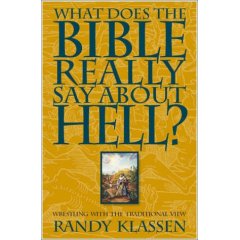 Book Reviews by Sondra Eklund
Book Reviews by Sondra Eklund

|
 |
|
Buy from Amazon.com
Rate this Book Sonderbooks 98 Next Book Nonfiction Christian Previous Book Next Book Fiction Young Adult Fiction Children's Nonfiction Children's Fiction Picture Books 2005 Stand-outs Previous Book Next Book 2004 Stand-outs 2003 Stand-outs 2002 Stand-outs 2001 Stand-outs Five-Star Books PreviousBook Next Book Four-Star Books Old Favorites Back Issues List of Reviews by Title List of Reviews by Author Why Read? Children and Books Links For Book Lovers Book Discussion Forum About Me Contact Me Subscribe Make a Donation I don't review books I don't like! *****= An all-time favorite |

*****What Does the Bible Really Say About Hell?Wrestling with the Traditional Viewby Randy Klassen Reviewed August 2, 2005.
Pandora Press, Telford, Pennsylvania, 2001. 144 pages. Sonderbooks Stand-out 2005 (#2, Christian Nonfiction) Those who have been reading my reviews for awhile know that my thinking was challenged by the writings of George MacDonald, found in such books as Knowing the Heart of God, and Discovering the Character of God. I came to believe that hell will not be permanent, but is a method used by a loving God to bring people to Himself, that eventually, “every knee will bow, and every tongue confess that Jesus Christ is Lord, to the glory of God the Father.” George MacDonald assures his readers that his views are in accordance with the Bible, but he doesn’t go into too much detail. I have a deep reverence for the words of Scripture, and I don’t want to believe anything that it doesn’t teach. I appreciated this book by Randy Klassen, because he specifically looks at everything the Bible says about hell and explains why its teachings may not actually match the traditional view of everlasting torment. First, he looks at the preaching of the apostles, fresh with the new revelation to proclaim. They did not preach about hell. They did preach about judgment, but not about hell. “Surely the preaching of those first messengers of the gospel, those nearest to the ministry of Jesus, ought to be a reliable model for us. Despite the godless character of their surrounding culture, they never felt the Spirit leading them to use threats of hell in their proclamations.” They focused on their risen Lord, not on threats of hellfire and damnation. Next, he looks at the Hebrew Bible, which didn’t have a concept of a fiery hell. “Sheol” is another word for the grave, and isn’t translated “hell” in newer translations. Of course, there are many Old Testament references to the wrath of God. However, there are also many references that say that his anger lasts a moment, but his favor lasts a lifetime. “He will not always accuse, nor will he harbor his anger forever,” says Psalm 103. Mr. Klassen goes into more detail with specific passages, concluding that “there is no clear teaching of a place of endless punishment in the Hebrew Bible, the Scriptures for first-century Christians. This would be one of the reasons why the apostles said very little about hell.” Then we come to the Gospels, which are more problematic. He looks at the passage in Mark 9:42-48: “ ‘A great millstone hung around the neck,’ ‘unquenchable fire,’ ‘hell, where their worm never dies,’—such are the colorful terms for God’s judgment on those sins. The language is typical rabbinical hyperbole. The image of fire is a perfect metaphor for the fire of God’s judgment. Jesus no more intended a literal description of hell than for his hearers to cut off their hands or legs or pluck out their eyes. Moreover, it is hardly consistent with all resurrection passages to imagine the saints rising with limbs or eyes missing!” He also talks about the word Gehenna, which is translated as “hell.” It was the name of the Valley of Hinnom, with an evil history. “Thereafter Gehenna became a sort of public incinerator. Always the fire smoldered in it, a pall of thick smoke lay over it, and it bred a loathsome kind of worm that was hard to kill. Often the bodies of the worst criminals would be deposited here. “It is obvious that Jesus did not mean evil persons would literally burn in the Valley of Hinnom. So it must have been understood the way the Pharisees had—as symbolic of the state of unrepentant sinners. Fire could represent the burning of guilt, the sentence of holy justice, the purging away of evil, or a final destruction. Whatever the precise meaning intended, Jesus is making it clear that the judgment of God is unquestionable.” Moving on to the epistles, Mr. Klassen reasons that they would emphasize what Jesus thought was important—and they don’t emphasize hell. “The apostles may have recognized better than we do the true meaning of the words Jesus used for hell and so, when they referred to judgment, they used terms their recipients, mostly Gentiles, could better understand.” Paul did preach a day of judgment. However, his preaching is full of the idea of ultimate victory, that, in the end, Christ will be all in all. Randy Klassen sums up this section saying, “What I am opting for is a recognition of both the judgment passages and the universal salvation passages…. For now let us affirm what the Bible teaches. There is salvation for all in Christ. There is a day of judgment and separation. Some are welcomed. Some are rejected (Matt. 25:32-46). Judgment, the wrath of God, falls on those who have rebelled against God’s ways. Then—how long is unknown—ultimately the victory is won for all and ‘every knee bows’ and ‘every tongue praises God’ (Rom. 14:11). “Since ‘eternal’ in the Hebrew Bible does not mean ‘endless days’ this surely must have been the understanding of Jesus and his disciples. In other words, hell is that state in which God’s judgment is executed until repentance is made and then redemption is given. God is the Lord of both the living and the dead, so we dare not limit God’s grace to the brief experience of our few days on earth.” In the rest of the book, he talks about the history of the traditional view, how it developed, and why he believes that it doesn’t fit the spirit of Christ’s teachings. He asks insightful questions, such as, “If we are encouraged by our Lord to love our enemies, how could continuous vindictive punishment fit with this same Lord who commanded mercy from us?” “Understandably a holy God will not ignore sin, not only because it mars his plan but also because it hurts the creatures God loves. Yet as the prophets have spoken, the justice of God is intended to heal not destroy, even though the path toward healing may include some destruction and pain.” “An eternal hell serves no purpose. If nothing is achieved but punishment for its own sake, then it is pointless.” “The big picture which the Bible paints is of a day when God will make all things new. It will be a new creation when death itself is destroyed and God ‘is all in all’ (I Cor. 15:28). So whatever else hell may be it cannot be ‘eternal.’ To say so is to degrade the victory of God in Christ.” “Therefore, I choose to hope. Being blessed by the grace of our risen Lord how can we not be filled with hope?” He concludes with a glorious poem: “God is eternal, Satan is not. Love is eternal, Evil is not. Light is eternal, Darkness is not. Joy is eternal, Misery is not. Heaven is eternal, Hell is not.” Amen. Reviews of related books: Exploring Universalism Copyright © 2005 Sondra Eklund. All
rights reserved. |